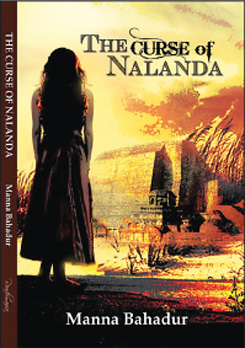
Raising parallels strikingly close to the present day scenario, the book highlights how in the current times, one can, because of the charm of fast paced growth, ignore advice and counsel
NALANDA, IN ITS prime, was one of the most revered seats of learning for Buddhist scholars. Even now, the university has a sense of enigma and reverence around it. It is this mysterious pull that author Manna Bahadur had based the idea of her second novel on. Its protagonist happens to be a journalist in search of “Breaking News”. So, this fast-paced thriller has been woven around an inferno that blazed in the Nalanda University and its annihilation by a Turkish invader.
The storyline revolves around the historic and traditional Nalanda University and its subsequent ransacking and destruction. Running in intersection with this narrative is the story of two girls — Devahuti and Chandni — belonging to two completely different eras and yet connected through time because of their experiences, betrayals, loyalties, confidence, as well as similarities in nature.
Chandni is a modern-day Journalist who is confident and a doer. Being a reporter, she has to cover the story about Nalanda University and when she reaches there for her professional assignment, the ruins of the Nalanda University start appearing to her and she loses to her subconscious mind and that's when she makes an attempt to comprehend it. Devahuti is a young child widow, deprived of love and belonging as well as her own desires — but the fearless girl is intellectually much ahead of her time. The similarity in the series of events in different eras connects Chandni and Devahuti and thus the curse that started with Devahuti comes to an end with Chandni, making the story more compelling.
Manna Bahadur digs into the backyard of her childhood, reaching into the past, veering back and forth, to spin a yarn shuttling between two timelines. In one, the bold and spritely child-widow Devahuti contends with the acts of a rampaging Bakhtiyar Khilji. In the other, TV journalist Chandni finds herself embroiled in mysteries beyond breaking news. Maintaining the pace of narration, The Curse of Nalanda, leads the reader to find answers as to how Devahuti and Chandni are intertwined and the book -- that is at once imagined history and contemporary reportage — turns out to be an edge-of-the-seat thriller.
Raising some parallels strikingly close to the present day scenario, the book also highlights how in the current times, one can, because of the charm of fast paced growth, ignore advice and counsel. The story does seem a bit predictable in places, but perhaps that has to do with the fact that the characters set in modern times are from amongst us. We will all have a friend in television — or at least read about media so much. The best bit about the book is the writing. It is very easy to fall into the trap of being verbose even when it is just not necessary. Bahadur writes in a language that we all speak, and therefore the book is an easy read. Despite that, relevant details that explain characters and their situations and circumstances are conveyed easily. For lovers of historic fiction, the book is an engaging and riveting read.
